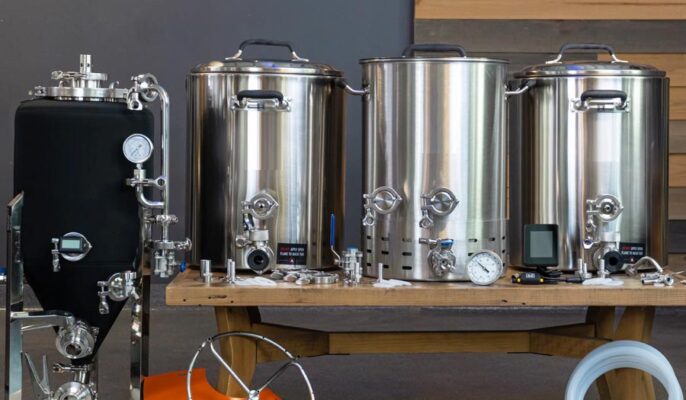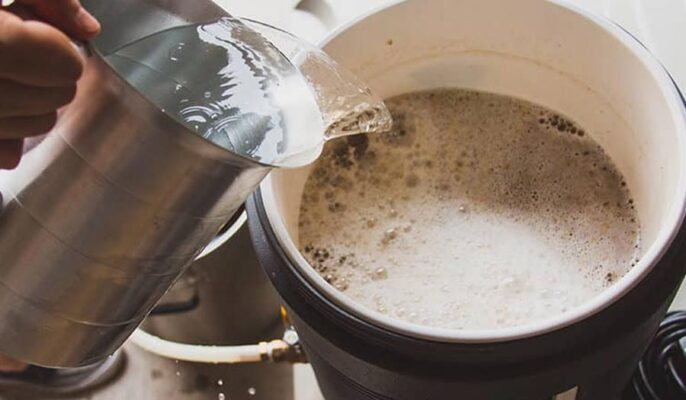All-grain brewing systems have led the way for many homebrewers to achieve their goal of all-grain brewing. There are many ways to configure a homebrew system. The best part is, you can start with a kettle. They are cost-effective, take up much less space, and can fit into many home environments. Beer is made from water, grains, hops and yeast. All-grain brewing is the process of brewing beer from scratch using crushed malted grains instead of malt extract. What sets each system apart is how the mashing part of the brewing process is handled. Once the mashing is complete, the rest of the process is the same.
Whole grain base
The main difference between whole grain brewing and extract brewing is who is producing the extracts that provide the base for the delicious beer. In the case of malt extract, converting barley malt into extract is done for you by someone else.
Malting barley is all about mashing: soaking the grains in hot water – converting starches into fermentable sugars and activating enzymes present in the grains.
Once the wort is produced in the brew tank, everything can be processed in the same way as extract brewing.

Choose whole grain equipment
All grains must some more equipment to get started. Depending on the type of whole grain system you choose, this could be as many as 3 dedicated containers or as simple as 1.
- Hot liquid tank (HLT): A storage tank for hot water used for brewing and spray water used for mashing.
- Mash Lauter Tun (MLT): A kettle or cooler used to preserve grains for mashing, the process of extracting fermentable sugars from the grains.
- Kettle: A vessel used for boiling fermentable wort and hops.
Choose fermentation container
After choosing a brewing system, you need to choose a container to ferment the beer. Many breweries start with plastic fermenters because they are cost-effective and easy to use. But, these can scratch and keep bacteria that will ruin your beer. If you want to know more about the options, you can contact MICET.
Accessories
- Mashing paddle helps you mix cereals
- Cleaners and disinfectants for cleaning brewing systems and fermentation vessels
- Hydrometer, used to measure the gravity of beer at the beginning and end of fermentation
- Bottling rod or siphon transfers beer to fermentation vessel
Beer in a bag (BIAB)
Beer in a bag has taken the homebrew world by storm. There are many high-end turnkey BIAB systems currently on the market for electric brewing. These systems feature recirculation, pumps, temperature control, and more. You can of course also use a very simple propane setup with a kettle, burner and mesh bag.
Can be mashed and boiled in a container. Place the grains in a large, very fine mesh bag and mash over direct heat. This is the easiest way to brew an all-grain recipe with minimal equipment and cleaning. Providing a simple and quick brew day.
Disadvantages are reduced brewhouse efficiency (68-72%) and the need to lift very hot/heavy grain bags out of the kettle after the mash is complete. Many breweries build some sort of pulley system to lift the grain bag and allow it to hang to drain out the last bits of wort.
2 cans of kettle (RIMS)
Dedicated mash tun (MLT) and direct-fired or electric kettle. The kettle-style RIMS system features full-volume mash and recirculation, allowing for grain filtration, wort clarification, and more even heat throughout the mash tun. 1-2 pumps are required to recirculate the mash from the mash tun to the boil kettle to heat and maintain the mash temperature. Since there is a dedicated mash vessel, there is no need for large grain bags.
The RIMS kettle has the advantage of providing more control over the BIAB and the ability to produce a clearer wort through grain bed filtration.
The disadvantage is that more equipment and a larger learning curve are required to adjust recirculation. It also requires cleaning extra kettles and pumps.
2-3 containers
The all-grain system is equipped with 2 stainless steel kettles and a cooling mash tun. Hot liquid tank + cold water kettle.
Before adding a pump to transfer the wort, it can be transferred from one container to another by pouring or gravity drainage. A cooler mash tun is a great way to maintain the mash temperature for an hour without any more heat source.
Add the stir water to the cooler along with the grains and seal the lid. Once the mash is complete, you can drain it into the boiling pot and rinse the grains with extra hot water from the HLT to extract any remaining sugars in a batch or drop spray. Since the system uses jetting (grain rinsing) you can achieve higher system efficiency than BIAB or Kettle RIMS.

Heat exchange recirculating saccharification system (HERMS)
A HERMS or heat exchange recirculating mash system is an efficient and sophisticated brewing system. It is designed for advanced homebrewers looking for the ultimate level of control over the mashing and brewing process. HERMS builds on many of the steps and components already mentioned above, but, the biggest difference is how the mash temperature is maintained. The biggest difference between HERMS and RIMS systems is the indirect versus direct heating of the wort during the mash process.
HERMS systems are very efficient (mid 80s and above) and use a injection method, which increases the duration of the brew day. One of the biggest advantages is the repeatability and tons of control.
Recirculating Infusion System (RIMS)
RIMS or circulating infusion glycation systems are very like HERMS functionality. As mentioned before, the biggest difference is how the wort is heated after it leaves the MLT. RIMS systems have heated RIMS tubes that heat the wort as it passes through the channel. The main advantages of this method are the step mashing and the rapid heating time of the mash.
Another way to achieve RIMS is to burn the MLT with gas or propane. Since the wort is recirculated, it is heated at the bottom and pumped to the top to distribute the heat.
There are as many different types of home brewing equipment as there are home breweries, but these are some basic requirements for all grain brewing.




